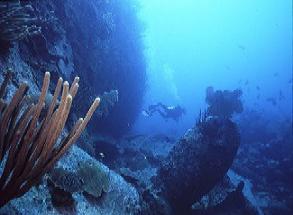The Iristo or Aristo
Sunk in Bermuda Waters on March 16, 1937
The Iristo was a most unlucky ship, wrecked because of another shipwreck. For the Norwegian steamer Iristo, on the morning of March 16 1937, truth turned out to be stranger than fiction. A victim of her captain's poor judgement, the Iristo ran into the same trap as the Spanish liner, Cristobal Colon. Unfamiliar with Bermuda reefs, her captain was surprised by the sight of the wreck of the Cristobal Colon.
At the time, the Cristobal Colon still sat high in the water, four and a half months after she ran aground. Unaware that the Spanish liner was supported by a barely submerged reef, the captain ordered his ship to turn away.
The course change caused the Iristo to crash into a submerged reef and subsequently sink. While under tow, the Iristo went down one mile east of the reef's northeast breakers. Captain Stephensen was brought before the Marine Board of Inquiry and summoned for the wreck of the Iristo. Originally named the Lake Jessup, this 250 foot Norwegian freighter was built by an American company in 1918, in Lorain, Ohio.
The Iristo was carrying a cargo of gasoline drums, a fire engine and steamroller. For a long time after the incident, the Iristo was called Aristo, because the New York Times misspelled her name.
Today, scarcely a mile and half from the scattered remains of the Cristobal Colon, the Iristo's resting place is well inside the reef that split her hull open. At 50 feet of water, she looks like a child's toy that has been twisted sharply. Her bow and stern sections, heavily overgrown with coral, sit opposite one another. The bow is within 18 feet of the surface.
Divers can see the remains of both the fire engine and steam roller originally bound for the island, as well as one of the ship's spare propellers (with its blades protruding up from the wreckage).
Rising from the middle of remains of this Bermuda's one of the famous shipwrecks are the massive steam engine, with two huge boilers. The top portions of it rests just 23 feet from the surface. They are heavily encrusted with large helmet sized colonies of Brain and Star Corals. Also, the ship's two-foot diameter propeller shaft now sits exposed.
The remains of a fire engine that was being carried as cargo can still be found. You need to look for it closely as nearly 60 years of heavy coral growth has disguised the fire engine considerably. There are also two large anchors visible. This wreck is considered by many as the best in Bermuda and is home to vast assortment of marine life.
Bermuda reputably has over 10,000 species of marine creatures in her waters. This is an excellent spot to see a large proportion of them. Look out for the ever-present schools of horse-eyed Jacks and the occasional Pompano or Permit. The east-end is often a great place for game fish - just ask your local fisherman.
Surrounded by stout coral heads, some as high as 35 feet, visibility at this site is often excellent and can reach more than 100 feet. In addition to being a member of the Bermuda Shipwreck Certificate program, the Iristo is a fun and photogenic wreck dive.
Check out
shipwreck map to get an idea about the location of this wreck in Atlantic.
|
 By Raj Bhattacharya By Raj Bhattacharya
Raj, a seasoned travel writer and Bermuda destination expert, has extensive global travel experience. This website reflects his profound insights, garnered over nearly two decades of dedicated findings and research on the island. Raj has assisted countless Bermuda-bound visitors by providing direct, personalized responses to their queries and imparting his wealth of knowledge through this platform. This site serves as an indispensable guide for those seeking informed and reliable insights into Bermuda's treasures.
|
Related Articles
1) Visit
Famous Bermuda Shipwrecks to know about amazing stories of many other famous ships that were wrecked in Bermuda waters.

 By Raj Bhattacharya
By Raj Bhattacharya